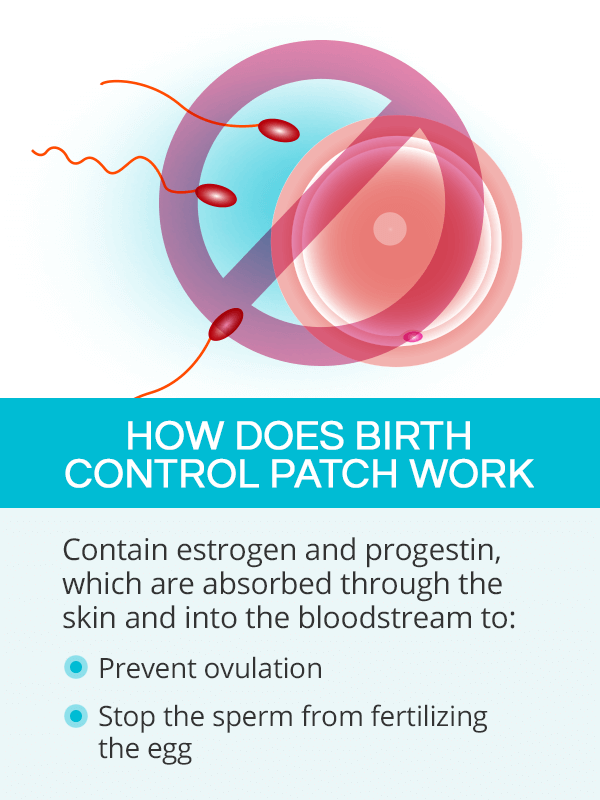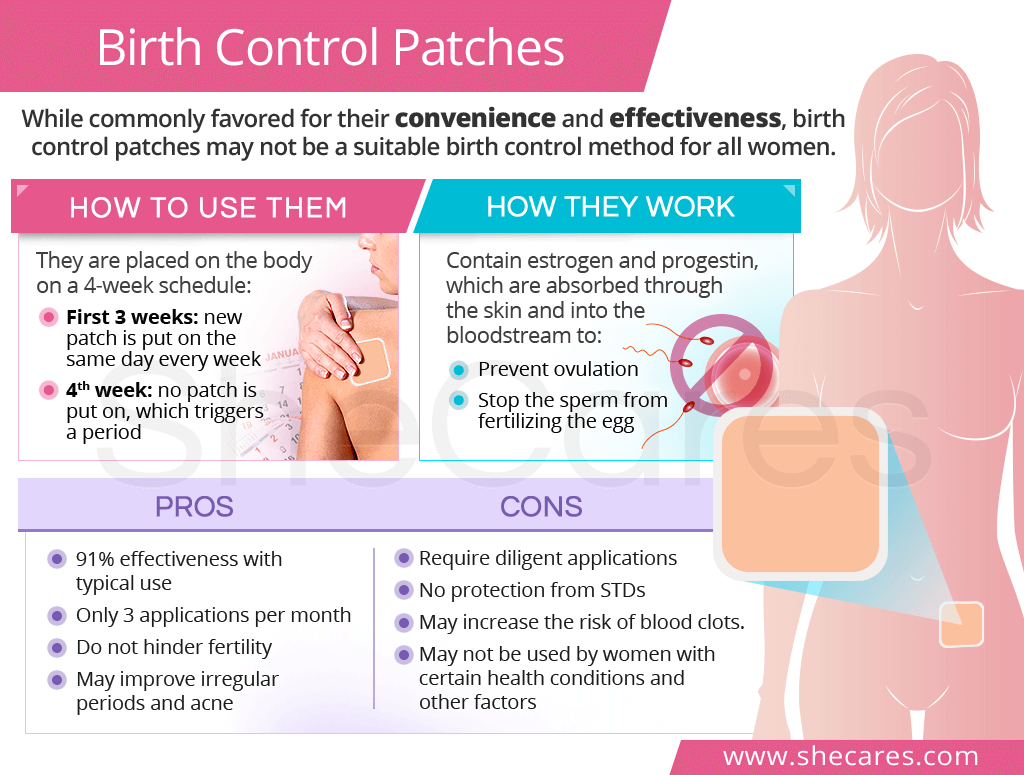About Birth Control Patches
A birth control patch is a transdermal birth control method that resembles a small adhesive bandage. It has a shape of a roughly 2x2-inch (4.5x4.5-cm) square with round edges.1
To date, there is only one brand of birth control patches, Xulane, sold on the US market. Ortho Evra, which was the first available FDA-approved contraceptive patch, is no longer offered in the United States.
Birth control patches are available for purchase through doctor's prescription only. Each pack contains three patches which can be applied by a woman herself, without doctor's assistance.
How to Use Birth Control Patches

Birth control patches are placed on the skin of the upper arm, abdomen, upper torso, or buttocks. They should not be placed on the breasts. It is recommended to switch sites between applications to avoid irritation.
Birth Control Patch Schedule
Women typically start using contraceptive patches either on the first day of their period or on the first Sunday after getting their period. The key is to apply them on the same day every week.
Each patch is placed on the body for seven days on a four-week schedule, which means the following:2
The patches are worn for three weeks (21 consecutive days), with a new patch being put on every week.
The fourth week is designated as the patch-free week, during which no patch is worn, and a woman should get her period.
Birth Control Patch Durability
The patch is water-resistant. As such, it is usually not prone to damage during baths, exercise, or swimming. In between subsequent applications, the patch should not be moved or taken off unless it is damaged.
If it does detach or become loose, a new patch should be applied right away. If it was off or loose for longer than 24 hours, it is recommended to use a backup birth control method, like condoms, for a week.2
How Do Birth Control Patches Work

A birth control patch contains synthetic hormones, estrogen and progestin (a form of progesterone), that resemble those naturally made in the body.
Once placed on the skin, contraceptive patches release the aforementioned hormones, which are absorbed through the skin and into the bloodstream. They prevent pregnancy through a two-fold mechanism:
Preventing ovulation, or egg release, to inhibit fertilization
Thickening cervical mucus to stop the sperm from reaching the egg
For first-time users starting their regimen on the first Sunday after their period started, it takes about one week for the patch to offer protection.2 A backup birth control method is, therefore, recommended.
Birth Control Patches Pros and Cons
When used correctly, birth control patches are an effective and reliable contraceptive method. However, there are several contraindications that must be considered when deciding whether the patch is a good fit.
Pros of Birth Control Patch

It is applied only three times a month, which is convenient and improves compliance.
With perfect use, the patch is 99% effective. However, with typical use (taking into account human error), the patch is 91% effective, meaning 9 in 100 women will not get pregnant while wearing it.3,4
Once the patch is discontinued, fertility usually returns right away without significant delays. However, cycles may be irregular for several months after discontinuation.
A steady hormone supply may ease irregular periods, like heavy periods or cramps. It may also reduce acne.
It can be used while breastfeeding, but only after the third week post-birth as it may affect milk production.
Cons of Birth Control Patch
It requires diligent, weekly applications for the patch to prevent pregnancy.
Contraceptive patches do not provide protection from sexually transmitted diseases (STDs).
Women who are older than 35, smoke, weigh more than 198 lb. (90 kg), and have heart problems, blood clots, or high blood pressure may not be able to use the patch.5
Because the patch may elevate estrogen levels in the blood, it may increase the risk of developing blood clots.6 It is also not recommended for women with a history of breast or uterine cancers.
Certain medications and herbal supplements may reduce the patch's effectiveness.
It can only be purchased through doctor's prescription, which involves higher costs and time commitment.
While some insurance policies may provide full or partial coverage, the out-of-pocket cost of birth control patches may be up $150 per pack.4
Key Takeaways
A patch control patch is a popular way to prevent pregnancy. While its once-per-week application schedule is praised for convenience, the patch does require considerate diligence in order to be effective. The patches contain synthetic estrogen and progesterone, which are absorbed through the skin. Once they enter the bloodstream, they prevent ovulation and fertilization. In real life, birth control patches are said to be 91% effective, although studies have shown 99% effectiveness with perfect use. The patch is favored for its convenience, lack of hindrance on fertility, and improvements in irregular periods. However, a woman's age, weight, health status, and other factors may mark it unsuitable for her use. As with all contraceptive methods, a doctor's consultation is the best way to choose appropriate options.
Sources
- American College of Obstetrician and Gynecologists. (n.d.). Combined Hormonal Birth Control: Pill, Patch, and Ring. Retrieved July 21, 2020 from https://www.acog.org/patient-resources/faqs/contraception/combined-hormonal-birth-control-pill-patch-and-ring
- American Pregnancy Association. (2013). Birth Control Patch. Retrieved July 21, 2020 from https://americanpregnancy.org/preventing-pregnancy/birth-control-patch/
- Brown University. (n.d.). Ortho Evra (The Patch). Retrieved July 21, 2020 from https://www.brown.edu/campus-life/health/services/promotion/sexual-health-contraception/ortho-evra-patch
- CDC. (n.d.). Effectiveness of Family Planning Methods. Retrieved July 21, 2020 from https://www.cdc.gov/reproductivehealth/UnintendedPregnancy/PDF/Contraceptive_methods_508.pdf
Footnotes:
- International Journal of Women's Health. (2017). Transdermal delivery of combined hormonal contraception: a review of the current literature. Retrieved July 21, 2020 from https://www.ncbi.nlm.nih.gov/pmc/articles/PMC5440026/
- Kids Health. (2017). Birth Control Patch. Retrieved July 21, 2020 from https://kidshealth.org/en/teens/contraception-patch.html
- Nationwide Children's. (2017). Birth Control: Contraceptive Patch. Retrieved July 21, 2020 from https://www.naationwidechildrens.org/family-resources-education/health-wellness-and-safety-resources/helping-hands/birth-control-contraceptive-patch
- Planned Parenthood. (n.d.). Birth Control Patch. Retrieved July 21, 2020 from https://www.plannedparenthood.org/learn/birth-control/birth-control-patch
- Mayo Clinic. (2019). Birth control patch. Retrieved July 21, 2020 from https://www.mayoclinic.org/tests-procedures/birth-control-patch/about/pac-20384553
- U.S. Department of Health & Human Services. (2019). Birth Control Patch. Retrieved July 21, 2020 from https://www.hhs.gov/opa/pregnancy-prevention/birth-control-methods/patch/index.html
